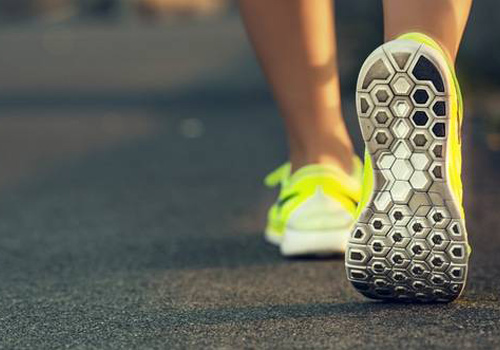Proper shoe wear is crucial for long-distance runners to prevent foot and ankle injuries. Here’s how shoe wear can play a role in injury prevention:
- Cushioning and Support: Running shoes are designed to provide cushioning and support to the foot, reducing the impact of each step on the joints and muscles. Proper cushioning can help absorb the shock of each step, reducing the risk of stress fractures and other overuse injuries. Supportive shoes can help reduce the risk of ankle sprains and other ligament injuries.
- Arch Support: The arch of the foot is a critical structure that helps distribute weight and absorb shock. For runners with low arches or flat feet, shoes with proper arch support can help distribute weight more evenly, reducing the risk of overuse injuries such as plantar fasciitis.
- Proper Fit: Running shoes should fit properly, with enough room in the toe box and a snug fit around the heel. Shoes that are too tight can cause blisters, while shoes that are too loose can cause the foot to slide around inside the shoe, leading to friction and rubbing.
In addition to these general guidelines, foot shape can also play a role in selecting the right running shoes. Here are some common foot shapes and the type of running shoe that may be best for each:
- Flat Feet: Runners with flat feet may benefit from shoes with good arch support, as this can help distribute weight more evenly across the foot.
- High Arches: Runners with high arches may benefit from shoes with extra cushioning, as this can help absorb the shock of each step.
- Wide Feet: Runners with wide feet should look for shoes with a wider toe box, to allow enough room for the toes to spread out.
- Narrow Feet: Runners with narrow feet should look for shoes with a more snug fit, to prevent the foot from sliding around inside the shoe.
- Pronation: Pronation refers to the natural inward rolling of the foot as it lands on the ground. Runners who overpronate (roll their feet too far inward) may benefit from shoes with extra support and stability, while runners who underpronate (roll their feet too far outward) may benefit from shoes with extra cushioning.
In summary, proper shoe wear is critical for long-distance runners to prevent foot and ankle injuries. Shoes with proper cushioning, support, and arch support can help distribute weight more evenly and reduce the impact of each step. The right shoe for each individual will depend on factors such as foot shape and pronation, and a running shoe specialist can help recommend the best shoe for each individual.
When it comes to selecting running shoes, there are several different types available. Here’s a closer look at some of the most common types of running shoes:
- Neutral or Cushioned Shoes: These shoes are designed for runners with a normal arch who do not overpronate (roll their feet too far inward) or underpronate (roll their feet too far outward). Neutral or cushioned shoes typically have a softer midsole and a more flexible sole, providing extra cushioning and shock absorption. These shoes are ideal for runners who want to maximize comfort and cushioning, and they can help prevent common injuries such as plantar fasciitis and stress fractures.
- Stability Shoes: Stability shoes are designed for runners who overpronate (roll their feet too far inward). These shoes have a firmer midsole and additional support features, such as a medial post or a different density of foam on the inside of the shoe. Stability shoes can help reduce the inward rolling of the foot and provide extra support for the arch, reducing the risk of injuries such as shin splints and knee pain.
- Motion Control Shoes: Motion control shoes are designed for runners who severely overpronate (roll their feet too far inward). These shoes are the most supportive and rigid of all running shoes, with a stiff midsole and a highly structured design. Motion control shoes can help prevent excessive inward rolling of the foot and reduce the risk of injuries such as plantar fasciitis and stress fractures.
- Minimalist Shoes: Minimalist shoes are a relatively new category of running shoes, designed to mimic the experience of running barefoot. These shoes have a very thin sole and little to no cushioning and are designed to allow the foot to move more naturally. Minimalist shoes can be helpful for runners who want to improve their running form, but they are not recommended for long-distance running, as they can increase the risk of foot and ankle injuries.
In addition to these general categories of running shoes, there are also shoes with extra cushioning or features designed for specific purposes, such as trail running or racing. It’s important to select a shoe that matches your foot type and running style and to work with a running shoe specialist who can help recommend the best shoe for your needs.







